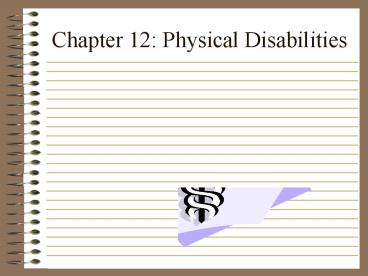Chapter 12: Physical Disabilities - PowerPoint PPT Presentation
1 / 15
Title:
Chapter 12: Physical Disabilities
Description:
B. Paraplegia: legs only. C. ... F. Diplegia: more affected in the legs than the arms ... May have sensitivity to temperature, pain, or position of legs ... – PowerPoint PPT presentation
Number of Views:193
Avg rating:3.0/5.0
Title: Chapter 12: Physical Disabilities
1
Chapter 12 Physical Disabilities
2
Orthopedic Disabilities Definition
- A severe orthopedic impairment that adversely
affects a childs educational performance. The
term includes impairments caused by congenital
anomaly (e.g., clubfoot, absence of some member,
etc.), impairments caused by disease (e.g.,
poliomyelitis, bone tuberculosis, etc.), and
impairments from other causes (e.g., cerebral
palsy, amputations, and fractures or burns that
cause contractures).
3
Cerebral Palsy
- Results from brain damage and does not get
progressively more impairing- occurs during
pregnancy, labor, in infancy, or in early
childhood - Nonprogressive and nonhereditary
- Types
- Spastic- most common rigid movements
- Athetoid- abrupt involuntary movements
- Ataxic- unsteadiness, lack of coordination
- Mixed- spastic and athetoid
- Mental retardation occurs in 50- 70 of cases
4
Topographical Classification
- Cerebral palsy is classified by type of movement
and body part affected - A. Monoplegia one limb
- B. Paraplegia legs only
- C. Hemiplegia one-half of body
- D. Triplegia three limbs (usually two legs and
one arm) - E. Quadriplegia all four limbs
- F. Diplegia more affected in the legs than the
arms - G. Double Hemiplegia arms more involved than
the legs
5
Spina Bifida
- Malformation of spinal cord during early days of
pregnancy- spinal column does not completely
close - The higher the defect, the more severe the loss
of function - Types
- spina bifida occulta- mildest found by x-ray
- meningocele- covering, but not cord, protrudes
abilities not lost - myelomeningocele- covering and cord protrude
6
Types of Spina Bifida
7
- Classroom issues
- shunt must be monitored
- Bladder and bowel control may be limited
- May have sensitivity to temperature, pain, or
position of legs - About 75 of kids with spina bifida have normal
intelligence but some have learning difficulties.
8
(No Transcript)
9
Muscular Dystrophy
- Includes nine hereditary muscle- destroying
disorders that vary inheritance pattern, age of
onset, initial muscles attacked, and rate of
progression - Duchennes disease- most common
- Scoliosis, a lateral curve of the spine, is
common in these students.
10
Prevalence
- U.S. Department of Education reported that
schools served 67,442 students, ages 6-21, who
have physical disabilities in the 1999-2000
school year.
11
Evaluation Process
- Types of evaluation
- Amniocentesis and ultrasonographic imaging of the
fetus assist physicians in diagnosing
disabilities before the baby is born. - Apgar screening- done right after birth and
checks sucking reflex, convulsions, stiffness or
an unusual amount of irritability and respiratory
problems - Ecological inventory, Electromyography, Muscular
biopsy, Discrepancy analysis - Physical therapists- Assessment
- Occupational therapists- upper-body movement fine
motor, and daily living activity
12
Effective Teaching Practices
- Curricular Goals
- Enhance functional mobility
- Increase communication
- Enhance capability to attend to daily living
skills - Maintain best physical health
- Achieve self-determination
13
Effective Teaching Practices
- Implement Instruction
- Augmentative and alternative communications
(AAC)- technical and strategies to assist with
communication - Medical technology assistance (tracheostomy,
jejunum tube, colostomy, pulseoximeter)
14
Progress in General Curriculum
- Practice Inclusion
- Development programs aimed at integrating
students with physical disability and their peers
without disabilities - Foster Collaboration
- Professional- school-based teams, including
district resource nurse to oversee multiple
services - Family- family and other professionals
collaborate with teachers and other professionals - Students and community- a buddy system helps
the student become an important member of the
team
15
Programs and Practice
- Early Childhood Years- enhances functional
mobility by utilizing technology tools such as an
eye-gaze board and a computer - Middle Years- a buddy system is utilized to
assist with adaptive equipment - Secondary Years- Pacific Northwest community
pairs adult mentors with students to engage in
learning and recreational activities - Transition and Postsecondary Years- UC Berkeley
utilizes trained care attendants to ensure
accessibility and appropriate education

